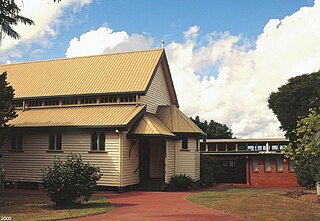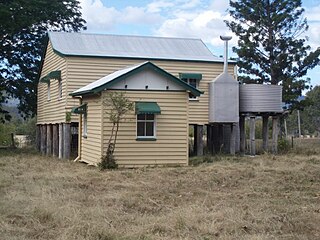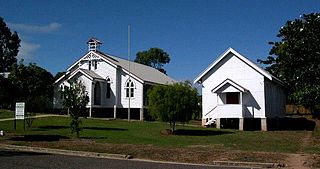
Gladstone is a city in the Gladstone Region, Queensland, Australia. It is approximately 550 km (340 mi) by road north-west of the state capital, Brisbane, and 100 km (62 mi) south-east of Rockhampton. Situated between the Calliope and Boyne Rivers, Gladstone is home to Queensland's largest multi-commodity shipping port.

Boyne Island is a coastal town and locality in Queensland, Australia, 25 kilometres (16 mi) south of Gladstone. It is part of the local government area of Gladstone Region. At the 2016 census, Boyne Island had a population of 4,760.

All Saints Anglican Church is a heritage-listed church at 32 Wickham Terrace, Spring Hill, City of Brisbane, Queensland, Australia. First founded in 1862, the current building designed by Benjamin Backhouse was completed in 1869, making it the oldest Anglican church in Brisbane. For most of its history, it has been identified with the High Church or Anglo-Catholic tradition within Anglicanism. It was added to the Queensland Heritage Register on 21 October 1992.

St Paul's Anglican Cathedral is an Australian heritage-listed cathedral at 89 William Street, Rockhampton, Rockhampton Region, Queensland. It was designed principally by Annersley Voysey and built from 1883 to 1953. It is also known as St Paul's Church of England and St Paul's Church of England Cathedral. It was added to the Queensland Heritage Register on 21 October 1992. The associated hall and offices were listed on the Queensland Heritage Register on 23 June 2000.

St Luke's Anglican Church is a heritage-listed church at 152 Herries Street, Toowoomba City, Queensland, Australia. It is the second church on the site and was designed by John Hingeston Buckeridge and built in 1897. It is also known as St Luke's Church of England. It was added to the Queensland Heritage Register on 28 July 2000.

Christ Church is a heritage-listed church at 24 Macrossan Street, Childers, Bundaberg Region, Queensland, Australia. It was designed by John Hingeston Buckeridge and built from 1900 to 1958. It is also known as the Anglican Church. It was added to the Queensland Heritage Register on 28 April 2000.

Yarwun is a coastal town and locality in the Gladstone Region, Queensland, Australia.

St James Church is a heritage-listed Anglican church at 145 Mort Street, Toowoomba, Queensland, Australia. It was designed by Richard George Suter and built from 1869 to 1953. It is also known as St James Church of England. It was added to the Queensland Heritage Register on 28 July 2000.

St John the Baptist Anglican Church is a heritage-listed church at 171 Oxford Street, Bulimba, Brisbane, Queensland, Australia. It was designed by John Hingeston Buckeridge and built in 1888 by T Whitty. It was added to the Queensland Heritage Register on 9 July 2003.

Christ Church Tingalpa and Burial Ground is a heritage-listed former Anglican church at 1341 Wynnum Road, Tingalpa, City of Brisbane, Queensland, Australia. It was built from 1868 to 1993. It is now known as the Pioneer Wedding Chapel. It was added to the Queensland Heritage Register on 2 February 1998.

St Brigid's Convent is a heritage-listed Roman Catholic convent at 9-17 Upper Clifton Terrace, Red Hill, City of Brisbane, Queensland, Australia. It was designed by Eaton & Bates and built from 1902 to 1923. It is also known as Convent of the Annuciation and Red Hill Convent. It was added to the Queensland Heritage Register on 28 March 2003.

St Josephs Cathedral is a heritage-listed Roman Catholic cathedral at 170 William Street, Allenstown, Rockhampton, Rockhampton Region, Queensland, Australia. It was designed by Francis Drummond Greville Stanley and built from 1893 to 1982. It was added to the Queensland Heritage Register on 21 October 1992.

Our Lady Star of the Sea Church & School is a heritage-listed Roman Catholic church and school at Goondoon Street, Gladstone, Gladstone Region, Queensland, Australia. It was built from 1924 to 1950. It was added to the Queensland Heritage Register on 21 October 1992.

Soldier Settler House is a heritage-listed homestead at Gladstone-Monto Road, Ubobo, Gladstone Region, Queensland, Australia. It was built in 1920. It is also known as Hecstanvale. It was added to the Queensland Heritage Register on 28 September 2001.

St Mary's Anglican Church is a State heritage-listed church at 11 Gordon Street, Mount Morgan, Rockhampton Region, Queensland, Australia. It was designed and built in 1888-1889 by Scottish-born Thomas Glen Cornes (1842-1903), superintendent of sawmills and carpenters at the Mount Morgan Gold Mining Company Limited. It was added to the Queensland Heritage Register on 25 August 2000.

St Paul's Anglican Cathedral Hall is a heritage-listed church hall at 89 William Street, Rockhampton, Rockhampton Region, Queensland, Australia. It is adjacent to St Paul's Anglican Cathedral. It was designed by Louis Spier Robertson and built c. 1900. It is also known as St Paul's Anglican Cathedral Offices, St Paul's Anglican Cathedral Parish Hall, and St Paul's Day School (1902-1912). It was added to the Queensland Heritage Register on 23 June 2000.

St Mark's Anglican Church is a heritage-listed church at 36 Larnach Street, Allenstown, Rockhampton, Rockhampton Region, Queensland, Australia. It was built in 1900. It was added to the Queensland Heritage Register on 28 July 2000.

St John's Anglican Church is a heritage-listed church at 278 Ford Street, Berserker, Rockhampton, Rockhampton Region, Queensland, Australia. It was built in 1912. It was added to the Queensland Heritage Register on 5 August 2003.

Christ Church Anglican Church is a heritage-listed church at Cannon Street, St Lawrence, Isaac Region, Queensland, Australia. It was designed by Alfred Mowbray Hutton and built in 1898 by Newman Brothers. It was added to the Queensland Heritage Register on 27 October 2000.

St John's Anglican Church Precinct is a heritage-listed churchyard at 30-34 Macrossan Street, South Townsville, City of Townsville, Queensland, Australia. It was built from c. 1907 to c. 1911. It was added to the Queensland Heritage Register on 21 October 1992.






















